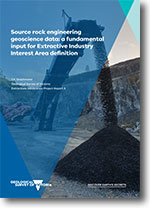EGPR 3 - Source rock engineering geoscience data: a fundamental input for Extractive Industry Interest Area definition
 |
| |||||
Product description:Executive Summary:Extractive Industry Interest Areas (EIIAs) were developed by the Geological Survey of Victoria (GSV) as an indicator of potential extractives prospectivity. The model for defining EIIAs focusses on regional geology, with local government planning schemes, location and transport routes identified as limiting factors. Valuation of a resource (both tangible production value and intangible future development potential) is a function of suitability of source rock for construction material supply and market conditions. The suitability of source rock for construction materials supply has been identified as critical for identification and definition of EIIAs as it is imperative to understanding the resource value. The engineering geoscience characteristics of a source rock (ability to meet engineering specifications) are controlled by the inherent geological properties. Therefore, geological properties, and engineering characteristics by extension, should be assigned the highest priority criteria for EIIA identification and delineation. EIIAs must be populated with quantifiable, relevant geoscience data including strength, hardness, durability and mineralogy to understand prospective and non-prospective areas. The benefit of this approach is that it provides an evidence base for informed decision-making as part of supply forecasts, location of demand and/or planning considerations. It also allows industry to focus their exploration and resources on the areas with the most suitable source rocks to deliver the production of in-demand construction materials. Geoscience evidence-based selection criteria for EIIAs requires a two-scale approach: macro-scale and micro-scale geology. Macro-scale geological characteristics, that control the local and regional distribution of geological units suitable for construction materials supply, contribute to the economic viability of a quarry operation and prospectivity of EIIAs. Prospective extractive resource areas should have minimal overburden, a thick, relatively uniform, accumulation of the target geological unit (>1:1) and lack large-scale structural features (i.e. geotechnically stable). The micro-scale geological characteristics of many source rock types determine the resultant construction material(s) that conform to engineering specifications. Hard rock in prospective areas should have non-reactive primary mineralogy, with only minor hydrothermal alteration and weathering, and low porosity and permeability; prospective unlithified deposits should have non-reactive mineralogy and material consistency at the deposit scale. Detailed understanding of prospective stratigraphy at macro- and micro-scale will facilitate evaluation of current EIIAs and allow the identification and delineation of potential new EIIAs. EIIA selection should consider a minimum set of engineering geoscience specifications that reflect the physical and chemical properties of the source rock, which are related to original deposition and/or post depositional processes. Bibliographic Reference: Drochmann, T.K., 2020. Source rock engineering geoscience data: a fundamental input for Extractive Industry Interest Area definition. Extractives Geoscience Project Technical Report 3. Geological Survey of Victoria. Department of Jobs, Precincts and Regions. Download: The downloadable version of this report is supplied in PDF format (4.3 MB). | ||||||

